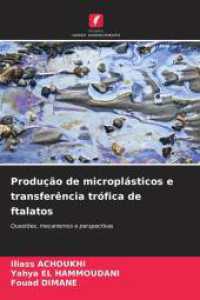- ホーム
- > 洋書
- > 英文書
- > Science / Mathematics
Full Description
The second edition covers a wide range of protein-protein interaction detection topics. Protein-Protein Interactions: Methods and Applications focuses on core technological platforms used to study protein-protein interactions and cutting-edge technologies that reflect recent scientific advances and the emerging focus on therapeutic discovery. Written in the highly successful Methods in Molecular Biology series format, chapters include introductions to their respective topics, lists of necessary materials and reagents, step-by-step laboratory protocols, and tips on troubleshooting and avoiding known pitfalls. These well-detailed protocols describe methods for identifying protein-protein interaction partners, analyzing of protein-protein interactions quantitatively and qualitatively, monitoring protein-protein interactions in live cells, and predicting and determining interaction interfaces.
Authoritative and cutting-edge, Protein-Protein Interactions: Methods and Applications, Second Edition is a valuable resource that will enable readers to elucidate the mechanisms of protein-protein interactions, determine the role of these interactions in diverse biological processes, and target protein-protein interactions for therapeutic discovery.
Contents
Structural basis of protein-protein interactions.- Quantitative analysis of protein-protein interactions.- Protein-protein interaction databases.- Computational prediction of protein-protein interactions.-- Structure-based computational approaches for small-molecule modulation of protein-protein interactions.- Targeting protein-protein interactions for drug discovery.- Studying protein-protein interactions using surface plasmon resonance.- Resonant waveguide grating for monitoring bimolecular interactions.- Quartz microbalance technology for probing biomolecular interactions.- Label-free kinetic analysis of an antibody-antigen interaction using biolayer interferometry.- Characterization of protein-protein interactions by isothermal titration calorimetry.- Sedimentation equilibrium studies.- Detecting protein-protein interactions by gel filtration chromatography.- Using light scattering to determine the stoichiometry of protein complexes.- Circular dichroism (CD) analyses of protein-protein interactions.- Protein-protein interaction analysis by nuclear magnetic resonance spectroscopy.- Quantitative protein analysis by mass spectrometry.- Using peptide arrays created by the SPOT method for defining protein-protein interactions.- Fluorescence polarization assay to quantify protein-protein interactions.- Förster resonance energy transfer (FRET) microscopy for monitoring biomolecular interactions.- Utilizing ELISA to monitor protein-protein interactions.- Glutathione-S-transferase (GST)-fusion based assays for studying protein-protein interactions.- Hexahistidine (6xHis) fusion-based assays for protein-protein interactions.- Studying protein-protein interactions via blot overlay/Far Western blot.- Co-immunoprecipitation from transfected cells.- In vivo protein cross-linking.- Identification of protein-protein interactions by standard Gal4p-based yeast two-hybrid screening.- Reverse two-hybrid techniques in the yeast Saccharomyces cerevisiae .-MAPPIT, a mammalian two-hybrid method for in-cell detection of protein-protein interactions.- Bioluminescence resonance energy transfer to detect protein-protein interactions in live cells.- Mapping biochemical networks with protein fragment complementation assays.- Detection of protein-protein interaction using bimolecular fluorescence complementation assay.- Split-luciferase complementation assay to detect channel-protein interactions in live cells.- Confocal microscopy for intracellular co-localization of proteins.- Fluorescence polarization assay to quantify protein-protein interactions in an HTS format.- Estrogen receptor alpha/co-activator interaction assay - TR-FRET.- High content screening biosensor assay to identify disruptors of p53-hDM2 protein-protein interactions.- Discovery of inhibitors of the MDM2-p53 protein-protein interaction.- Biophysical methods for identifying fragment-based inhibitors of protein-protein interactions.








